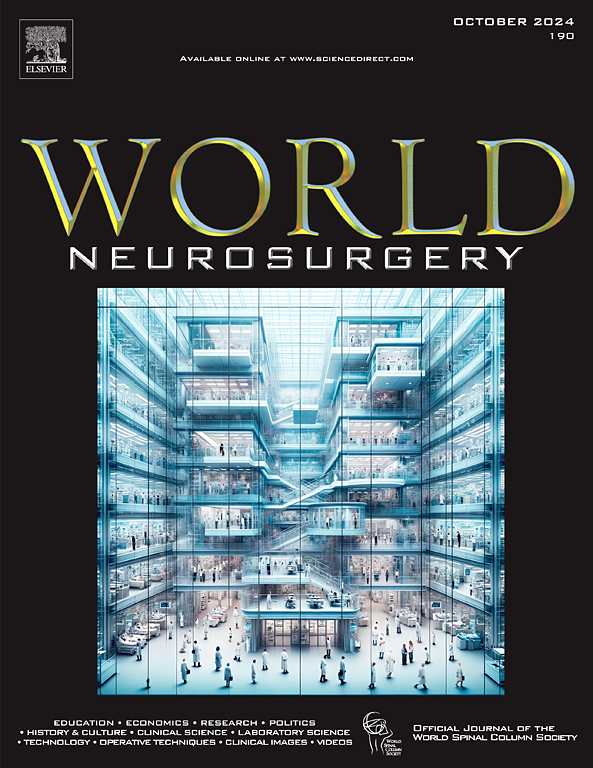Systematic Review of Surgical Success, Complications, Revision Rates, Radiation Dosage, and Operative Time of 3D-Navigated versus Non-Navigated Spinal Procedures
IF 1.9
4区 医学
Q3 CLINICAL NEUROLOGY
引用次数: 0
Abstract
Objective
Three-dimensional (3D) navigation offers real-time guidance in surgery. However, there is limited and inconsistent data regarding the usability, safety, and efficacy. To address gaps in knowledge about 3D navigation in spinal surgery, we conducted a comprehensive review of success rates, complications, revisions, radiation exposure, and operative time associated with Federal and Drug Administration-approved 3D surgical navigation tools.
Methods
This study adhered to Preferred Reporting Items for Systematic Reviews and Meta-Analyses guidelines and used a protocol registered on International Prospective Registration of Systematic Reviews (CRD42023404554). Ovid MEDLINE, Embase, and Cochrane Central Register of Controlled Trials databases were searched using relevant keywords for 3D surgical navigation and spinal procedures from 1946 to March 02, 2023. Two independent reviewers assessed the studies using inclusion/exclusion criteria and risk of bias tools. Statistical analyses included one-way analysis of variance, weighted-mean difference, and unpaired t-tests with Welch's correction for associations and comparisons between groups, respectively.
Results
Of the total 11,324 studies identified and 7198 screened, 62 studies totaling 3170 adult patients were included in this comprehensive review. Complication and surgical success rates have remained constant since 2004, with overall rates of 5.5% and 94.0%, respectively. When segmented by spinal region, complication rates may be moderately positively correlated with frequency of cervical and thoracic procedures (r = 0.25, P = 0.68). The most commonly reported complication was pedicle screw malposition or breach. A subset of 20 studies, totaling 1554 patients, compared the performance of 3D navigation to two-dimensional fluoroscopy or freehand navigation. There was a significant difference of 6.53% between surgical success rates of the 3D-navigated and control groups (P = 0.03). However, there was no significant difference in radiation exposure or operative time.
Conclusions
The 3D navigation in spinal procedures has higher surgical success rates than two-dimensional fluoroscopy and freehand navigation. Included studies exhibited varying limitations, including no patient follow-up (n = 1), less than 10 patients (n = 6), various types of spinal disorders (n = 1), and varying comorbidities among participants (n = 2). Improving 3D navigation tools remains imperative to decrease operative time and radiation exposure.
三维导航与非导航脊柱手术的手术成功率、并发症、翻修率、放射剂量和手术时间的系统性回顾。
目的:三维导航为手术提供实时指导。然而,关于可用性、安全性和有效性的数据有限且不一致。为了解决脊柱手术中3D导航知识的空白,我们对fda批准的3D手术导航工具的成功率、并发症、修复、辐射暴露和手术时间进行了全面的回顾。方法:本研究遵循PRISMA指南,使用在PROSPERO (CRD42023404554)上注册的方案。使用1946年至2023年3月2日期间的3D外科导航和脊柱手术相关关键词检索Ovid MEDLINE、Embase和Cochrane Central Register of Controlled Trials数据库。两名独立审稿人使用纳入/排除标准和偏倚风险工具对研究进行评估。统计分析包括单因素方差分析、加权平均差异和未配对t检验,分别对组间的关联和比较进行Welch校正。结果:在确定的11,324项研究和筛选的7198项研究中,62项研究共计3,170名成年患者被纳入本综合综述。自2004年以来,并发症和手术成功率保持不变,总体发生率分别为5.5%和94.0%。当按脊柱区域分段时,并发症发生率可能与颈椎和胸椎手术的频率中度正相关(r = 0.25, p = 0.68)。最常见的并发症是椎弓根螺钉错位或断裂。20项研究的一个子集,总共1554名患者,比较了3D导航与2D透视或徒手导航的性能。3d导航组与对照组手术成功率比较,差异有统计学意义(p = 0.03),分别为6.53%。然而,两组在放射照射和手术时间上无显著差异。结论:三维导航在脊柱手术中的成功率高于二维透视和徒手导航。纳入的研究显示出不同的局限性,包括没有患者随访(n = 1),少于10例患者(n = 6),各种类型的脊柱疾病(n = 1),以及参与者中不同的合共病(n = 2)。改进3D导航工具仍然是减少手术时间和辐射暴露的必要条件。
本文章由计算机程序翻译,如有差异,请以英文原文为准。
求助全文
约1分钟内获得全文
求助全文
来源期刊

World neurosurgery
CLINICAL NEUROLOGY-SURGERY
CiteScore
3.90
自引率
15.00%
发文量
1765
审稿时长
47 days
期刊介绍:
World Neurosurgery has an open access mirror journal World Neurosurgery: X, sharing the same aims and scope, editorial team, submission system and rigorous peer review.
The journal''s mission is to:
-To provide a first-class international forum and a 2-way conduit for dialogue that is relevant to neurosurgeons and providers who care for neurosurgery patients. The categories of the exchanged information include clinical and basic science, as well as global information that provide social, political, educational, economic, cultural or societal insights and knowledge that are of significance and relevance to worldwide neurosurgery patient care.
-To act as a primary intellectual catalyst for the stimulation of creativity, the creation of new knowledge, and the enhancement of quality neurosurgical care worldwide.
-To provide a forum for communication that enriches the lives of all neurosurgeons and their colleagues; and, in so doing, enriches the lives of their patients.
Topics to be addressed in World Neurosurgery include: EDUCATION, ECONOMICS, RESEARCH, POLITICS, HISTORY, CULTURE, CLINICAL SCIENCE, LABORATORY SCIENCE, TECHNOLOGY, OPERATIVE TECHNIQUES, CLINICAL IMAGES, VIDEOS
 求助内容:
求助内容: 应助结果提醒方式:
应助结果提醒方式:


